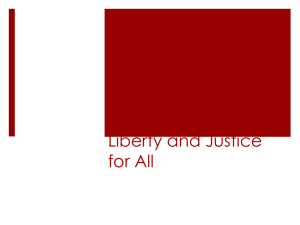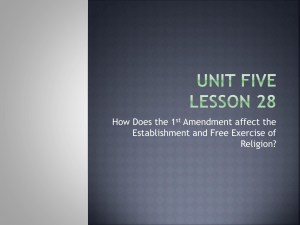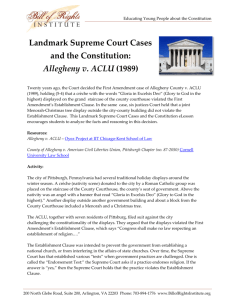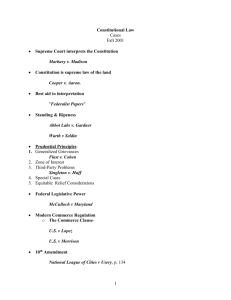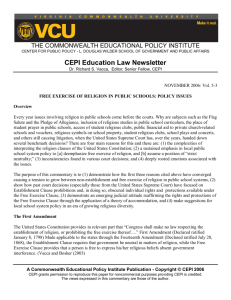constitutional law - Bingham High School
advertisement
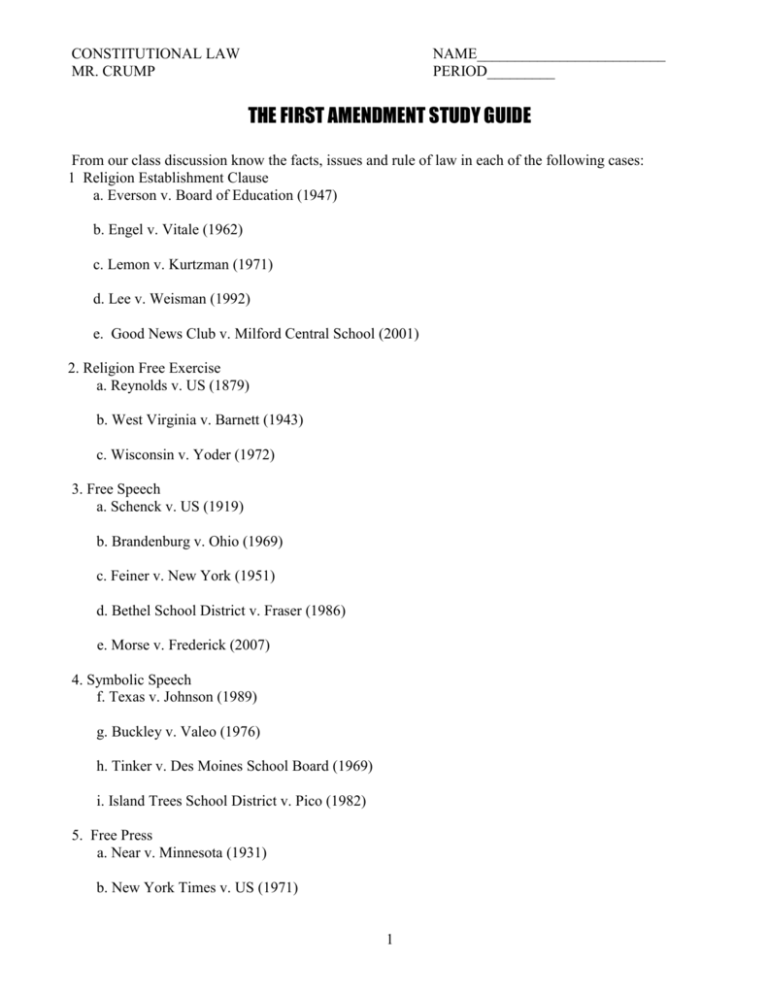
CONSTITUTIONAL LAW MR. CRUMP NAME_________________________ PERIOD_________ THE FIRST AMENDMENT STUDY GUIDE From our class discussion know the facts, issues and rule of law in each of the following cases: 1 Religion Establishment Clause a. Everson v. Board of Education (1947) b. Engel v. Vitale (1962) c. Lemon v. Kurtzman (1971) d. Lee v. Weisman (1992) e. Good News Club v. Milford Central School (2001) 2. Religion Free Exercise a. Reynolds v. US (1879) b. West Virginia v. Barnett (1943) c. Wisconsin v. Yoder (1972) 3. Free Speech a. Schenck v. US (1919) b. Brandenburg v. Ohio (1969) c. Feiner v. New York (1951) d. Bethel School District v. Fraser (1986) e. Morse v. Frederick (2007) 4. Symbolic Speech f. Texas v. Johnson (1989) g. Buckley v. Valeo (1976) h. Tinker v. Des Moines School Board (1969) i. Island Trees School District v. Pico (1982) 5. Free Press a. Near v. Minnesota (1931) b. New York Times v. US (1971) 1 c. New York Times v. Sullivan (1964) d. Miller v. California (1973) e. Hazelwood School District v. Kuhlmeier (1988) 6. Free Assembly a. DeJonge v. Oregon (1937) b. Edwards v. South Carolina (1963) c. Adderley v. Florida (1966) Read Chapter 3 (The First Amendment) This part you fill in. 1. Why are the First Amendment rights essential to a democratic government? 2. Why is the opening phrase of the First Amendment “Congress shall make no law” important? 3. What is the significance of the case of Barron v. Baltimore (1833) and what has caused this decision to be changed? 4. What is the current interpretation of the restrictions made by the Bill of Rights? What does it say about private actions? 5. What are the differences between the Establishment Clause and the Free Exercise Clause of the First Amendment? a. Establishment Clause b. Free Exercise Clause 6. In Colonial America what was the relationship between church and state? What were some of the religious requirements required by colonial governments? 7. What is the difference between religious toleration and free of religion? 2 8. What did Roger Williams do to advance religious freedom in Colonial America? 9. What was the significance of the Virginia Statute of Religious Liberty? What freedoms did it provide? 10. What religious liberty is protected in the text of the original Constitution? What two protections were added in the Bill of Rights? Establishment Clause 11. What did the Thomas Jefferson say about the Establishment Clause? 12. What did the Supreme Court say about the meaning of the Establishment Clause in the case of Everson v. Board of Education? 13. What is the difference between the views of the separationists and the accomodationists on religion? 14. What is the three part test for religious separation in the case of Lemon v. Kurtzman (1971)? What has happened to the excessive entanglement test in recent years? 15. Explain the current legal status of the following in relation to the Establishment Clause: a. released time b. aide to religious or parochial schools c. school prayer d. evolution 3 e. equal access to school facilities 16. How has the Establishment Clause been interpreted to apply to the following? a. government holiday displays b. prayer in legislatures c. Sunday closing laws d. tax exemptions for religious organizations Free Exercise Clause 18. What does the Free Exercise Clause test? 19. Explain the significance of the following cases: a. Reynolds v. United States (1879) b. Cantwell v. Connecticut (1940) c. West Virginia v. Barnett (1943) 20. Explain how the “compelling interest” test works in Free Exercise cases. 21. What has the Supreme Court said about the Free Exercise clause and the following? a. unemployment benefits b. compulsory education 4 c. conscientious objectors d. Social Security e. racial discrimination f. military dress 22. How has the compelling interest test been modified by the Smith test? 23. What did the Religious Freedoms Restoration Act do? What is its current status? Freedom of Speech 1. Why is freedom of Speech essential to a democratic government? 2. Discuss the significance of the following in the evolution of free speech: a. the Sedition Act of 1798 b. Civil War Era c. The Labor Movement d. World War I and the Espionage Act of 1917 3. What is the significance of the case of Gitlow v. New York? 5 4. Explain the difference between pure speech and symbolic speech? 5. What has the Supreme Court ruled about the following kinds of speech? a. burning draft cards b. flag burning 6. What is meant by the public forum? What are the rules for free speech in the public forum? How may the government restrict speech in the public forum? 7. How does over breadth and vagueness apply to free speech? What is an example of each? 8. What are two examples of a person’s right not to speak? 9. What are the rules for government speech? 10. What is the significance of Buckley v. Valeo? 11. What rules did Miller v. California (1973) set down to determine obscenity speech that is not protected by the First Amendment? 12. Explain the current limits on free speech for each of the following circumstances: a. obscenity b. defamation of character c. fighting words and hate speech 6 d. commercial speech 13. What has the Supreme Court said about free speech in public schools? 14. Describe the following tests for free speech: a. Clear and Present Danger Test (Schenck v. US) b. Imminent Action Test (Brandenburg v. Ohio) 15. What does the marketplace of ideas model say about free speech? How does it apply to the Skokie Nazi Case? Freedom of the Press 1. What are the English roots of Freedom of the Press? 2. What is the significance of the John Peter Zenger case and freedom of the press? 3. What is prior restraint? 4. What did the Supreme Court rule about freedom of the press in the following cases? a. Near v. Minnesota (1931) b. New York Times v. US (1971) The Pentagon Papers Case c. a defendant’s right to a fair trial 7 5. What are permissible prior restraints? 6. What is libel? What are the rules for libel as set down in the case of New York Times v. Sullivan? 7. What has the Supreme Court said about a reporter’s right to keep his sources confidential? What is a shield law? 8. Explain what the courts have said about freedom of the press and the following: a. motion pictures b. radio and television c. cable television Freedom of Assembly and Petition 1. How are Freedom of Assembly and Petition related? How has their relation changed over the years? 2. Outline the status of Freedom of Assembly and Petition before 1791 in a. England b. Colonial America c. After the Revolutionary War in America 8 d. Why were some legislators opposed to putting Freedom of Assembly in the Constitution? 3. What did the Supreme Court say about assembly in the case of DeJonge v. Oregon (1937)? 4. What does peaceful assembly mean? What restrictions may the government make on assembly? 5. What did the Supreme Court say about assembly in the case of Hague v. Ohio (1939)? 6. What rules apply to assembly on public property? Assembly on private property? 7. What did the Supreme Court say about peaceful assembly and hostile audiences in the cases of: a. Feiner v. New York (1951) b. Gregory v. Chicago (1969) 8. What have the courts said about Freedom of Association? 9. What are the rules about Freedom of Association in the following? a. making public organization membership lists b. teachers taking anticommunist loyalty oaths c. civic club memberships 9 10
